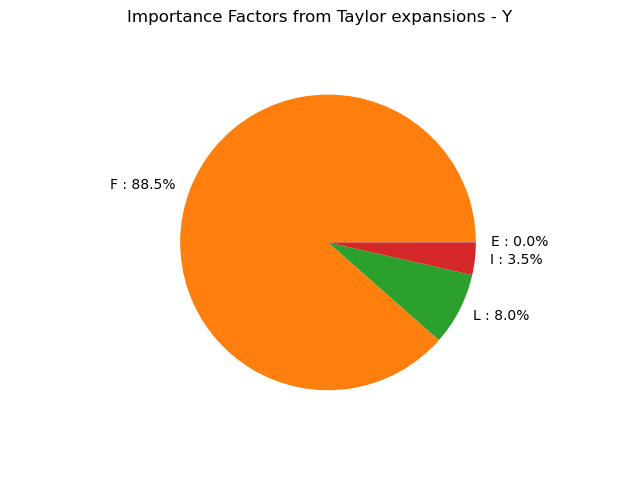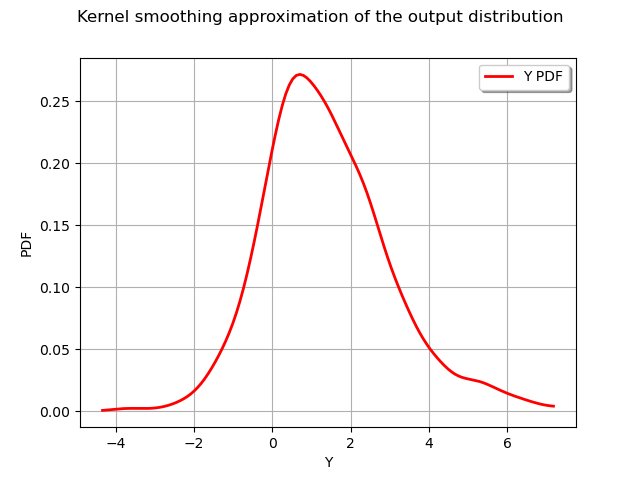Note
Go to the end to download the full example code
Analyse the central tendency of a cantilever beam¶
In this example we perform a central tendency analysis of a random variable Y using the various methods available. We consider the cantilever beam example and show how to use the TaylorExpansionMoments and ExpectationSimulationAlgorithm classes.
from openturns.usecases import cantilever_beam
import openturns as ot
import openturns.viewer as viewer
from matplotlib import pylab as plt
ot.Log.Show(ot.Log.NONE)
We first load the data class from the usecases module :
cb = cantilever_beam.CantileverBeam()
We want to create the random variable of interest Y=g(X) where is the physical model and
is the input vectors. For this example we consider independent marginals.
We set a mean vector and a unitary standard deviation :
dim = cb.dim
mean = [50.0, 1.0, 10.0, 5.0]
sigma = [1.0] * dim
R = ot.IdentityMatrix(dim)
We create the input parameters distribution and make a random vector :
distribution = ot.Normal(mean, sigma, R)
X = ot.RandomVector(distribution)
X.setDescription(["E", "F", "L", "I"])
f is the cantilever beam model :
f = cb.model
The random variable of interest Y is then
Y = ot.CompositeRandomVector(f, X)
Y.setDescription("Y")
Taylor expansion¶
Perform Taylor approximation to get the expected value of Y and the importance factors.
taylor = ot.TaylorExpansionMoments(Y)
taylor_mean_fo = taylor.getMeanFirstOrder()
taylor_mean_so = taylor.getMeanSecondOrder()
taylor_cov = taylor.getCovariance()
taylor_if = taylor.getImportanceFactors()
print("model evaluation calls number=", f.getGradientCallsNumber())
print("model gradient calls number=", f.getGradientCallsNumber())
print("model hessian calls number=", f.getHessianCallsNumber())
print("taylor mean first order=", taylor_mean_fo)
print("taylor variance=", taylor_cov)
print("taylor importance factors=", taylor_if)
model evaluation calls number= 1
model gradient calls number= 1
model hessian calls number= 1
taylor mean first order= [1.33333]
taylor variance= [[ 2.0096 ]]
taylor importance factors= [E : 0.000353857, F : 0.884642, L : 0.079618, I : 0.0353857]
graph = taylor.drawImportanceFactors()
view = viewer.View(graph)

We see that, at first order, the variable explains 88.5% of the variance of the output
. On the other hand, the variable
is not significant in the variance of the output: at first order, the random variable
could be replaced by a constant with no change to the output variance.
Monte-Carlo simulation¶
Perform a Monte Carlo simulation of Y to estimate its mean.
algo = ot.ExpectationSimulationAlgorithm(Y)
algo.setMaximumOuterSampling(1000)
algo.setCoefficientOfVariationCriterionType("NONE")
algo.run()
print("model evaluation calls number=", f.getEvaluationCallsNumber())
expectation_result = algo.getResult()
expectation_mean = expectation_result.getExpectationEstimate()
print(
"monte carlo mean=",
expectation_mean,
"var=",
expectation_result.getVarianceEstimate(),
)
model evaluation calls number= 1001
monte carlo mean= [1.45846] var= [0.00299836]
Central dispersion analysis based on a sample¶
Directly compute statistical moments based on a sample of Y. Sometimes the probabilistic model is not available and the study needs to start from the data.
Y_s = Y.getSample(1000)
y_mean = Y_s.computeMean()
y_stddev = Y_s.computeStandardDeviation()
y_quantile_95p = Y_s.computeQuantilePerComponent(0.95)
print("mean=", y_mean, "stddev=", y_stddev, "quantile@95%", y_quantile_95p)
mean= [1.40943] stddev= [1.63795] quantile@95% [4.36899]
graph = ot.KernelSmoothing().build(Y_s).drawPDF()
graph.setTitle("Kernel smoothing approximation of the output distribution")
view = viewer.View(graph)
plt.show()

Total running time of the script: ( 0 minutes 0.160 seconds)
 OpenTURNS
OpenTURNS